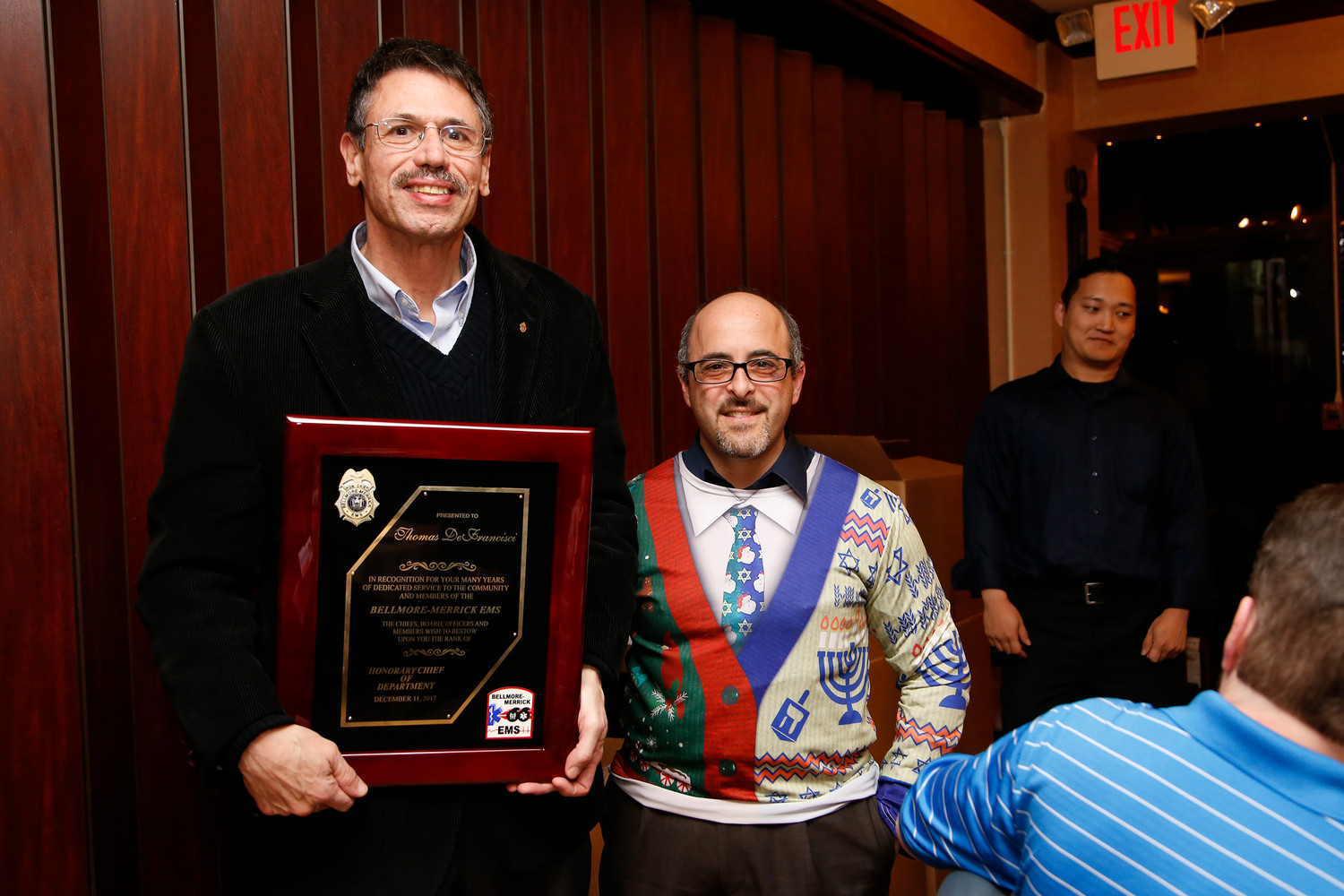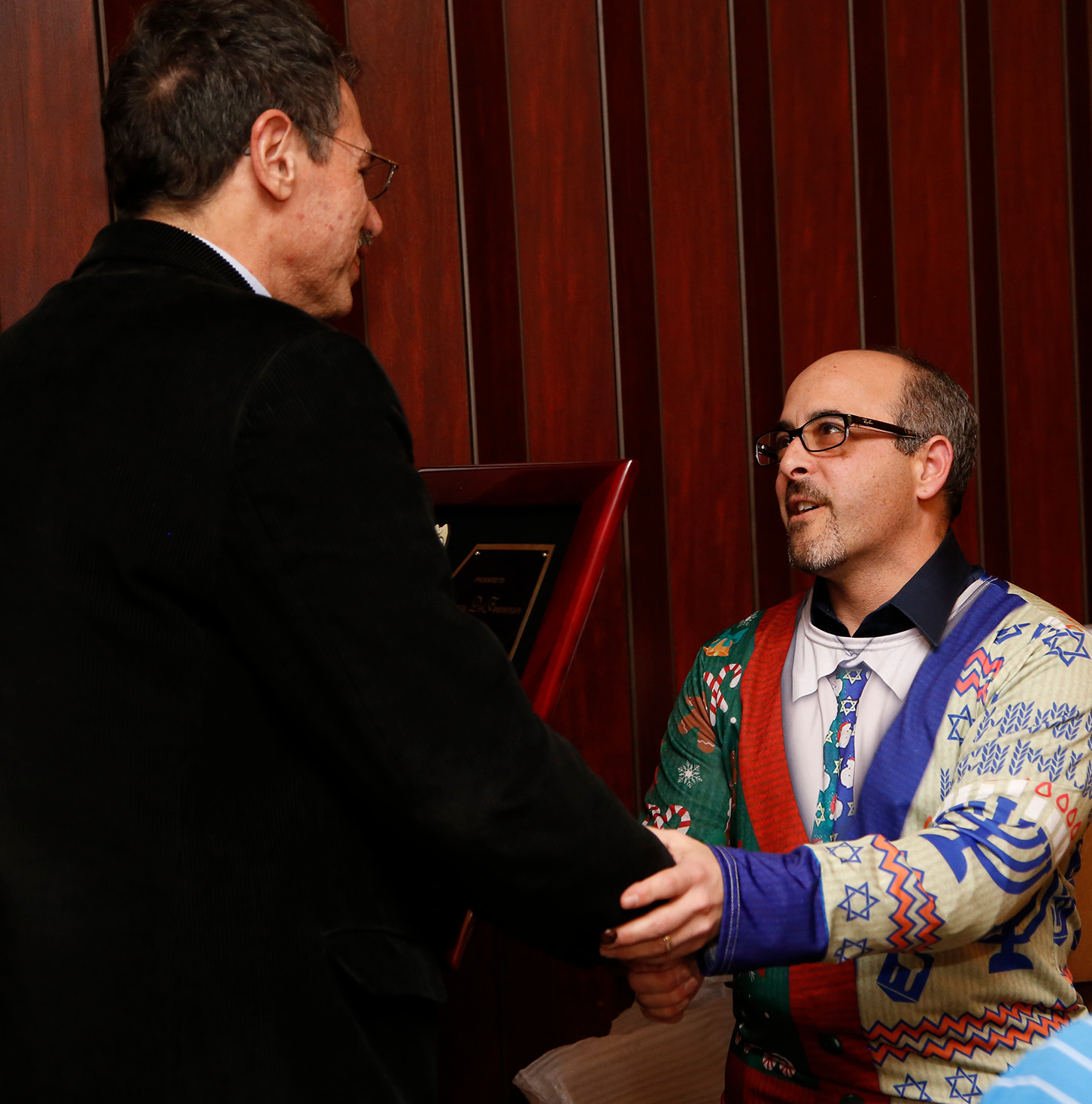Thomas DeFrancisci named honorary chief of Bellmore-Merrick EMS
Thomas DeFrancisci, 60, of Bellmore was recognized as honorary chief of the Bellmore-Merrick EMS at their annual dinner on Dec. 11.
When Thomas DeFrancisci, 60, of Bellmore, began volunteering with the Bellmore-Merrick Emergency Medical Services, he wouldn’t always drive to the residents who made emergency calls. He would run to them.
“And I always beat the crew,” he said, explaining that he lives in North Bellmore, but there is a traffic light on his block. To ensure a quick response, he ran to the North Bellmore calls.
Still in ‘the pile,’ 16 years later
DeFrancisci, a father of three, recalled wading through six inches of a powdery dust that looked like snow. He was one of the 20 Bellmore-Merrick EMS volunteers who rushed to ground zero after the Sept. 11 attacks to aid in the grand-scale recovery efforts.
The pile, as it is often called, was the destroyed remains of the World Trade Center, and the dust that DeFrancisci remembers was a combination of jet fuel, cement, asbestos, silica, microscopic glass shards, heavy metals, pulverized construction materials and carbon nanotubes. “I can still remember the taste,” DeFrancisci said, “The metallic taste.”
Since September, he has been working with the Bellmore-Merrick EMS on disability benefits. He, Resnik and their friend Kevin Kelly were diagnosed by the World Trade Center Health Program with 9/11-related diseases.
Resnik recovered fully after overcoming kidney cancer. Kelly died in 2015 after a long battle with a severe respiratory illness. He was posthumously recognized as the first honorary chief of the Bellmore-Merrick EMS. DeFrancisci is still fighting carcinoid cancer, a rare tumor that grows in the main airways of the lungs, with which he was diagnosed in 2008.
Finding support
DeFrancisci said that he bought into the “fairy tale” about carcinoid cancer: He thought that an operation could remove the tumor and defeat the cancer. On a cold day in 2009, he underwent the surgery at the Memorial Sloan Kettering Cancer Center. He recalled meeting people who were battling lung cancer and then seeing them smoke cigarettes outside in the cold.
The tumor was removed, and DeFrancisci contacted a carcinoid cancer support group called the Neuroendocrine Cancer Awareness Network, in North Bellmore. He still meets with the group, where the members refer to one another as “lungnoids,” to seek support and to help those who are in worse shape, he said.
DeFrancisci is also enrolled in the WTC Health Program, along with 79,906 other first responders and civilians who have lasting effects because of the events 16 years ago.
The program wouldn’t exist without passage of the Zadroga 9/11 Health Act, named after a New York City Police Department officer who responded to the attacks and died of a related respiratory illness. It expired in October 2015, only to be reauthorized two months later, with support from lawmakers and civilians. The Herald covered its debate in congress in an article called "9/11 rescuers still living a nightmare," published November 2015.
“If it wasn’t for that program,” Resnik said, “thousands and thousands of people throughout the country wouldn’t get the care and treatment they need.”
Supporting others
In 2011, DeFrancisci discovered that his carcinoid cancer had metastasized. Since then, he had been undergoing chemotherapy and had been on medical leave from the Bellmore-Merrick EMS until he applied for disability benefits in September.
“I want to bring things back in my life,” he said. He can no longer ride in an ambulance — or run to emergency calls. As a former architect at the Diocese of Rockville Centre, however, he is seeking to help with construction and renovation projects at the Bellmore-Merrick EMS building.
“I consider [DeFrancisci] somebody that I look up to,” Resnik said. “He is really what volunteerism in the emergency- services world is all about. He barrels through things and never lets it seem to slow him down.”
DeFrancisci said that he looks forward to this new chapter with the organization, and is inspired by the new generation of volunteers, some of whom are still in high school.
“This organization has been so important to me for so many years,” he said. “When someone’s having an emergency, they think to call [us]. How many times can you say that you’ve truly helped someone?”

 63.0°,
A Few Clouds and Breezy
63.0°,
A Few Clouds and Breezy 







